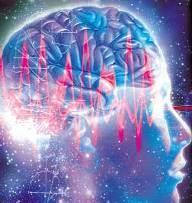Brains: The mind as matter
The exhibition has four sections. The first, Measuring/Classifying, introduces efforts to define the relationship between the brain's function and form. If microscopic cellular staining techniques developed in the late 19th century enabled a new understanding of localised neural processes, the rise of phrenology and anthropometry shows the ease with which societal prejudice fed into analysis of brain shape and size. From Bernard Hollander's cranial measuring system to the tools of phrenology, the skewed morality of these pseudo-sciences illustrates the measuring of brains as a measure of culture.
Mapping/Modelling follows the attempts to represent the anatomy of the brain. From early visualisations by Reisch, Vesalius and Descartes in the 16th and 17th centuries to the kaleidoscopic Brainbow images of nerve cells created by Jeff Lichtman and his team, the artistic drive to apprehend the complexities of the brain follow the increasing philosophical and medical understanding of its centrality to our being. Wax models show extraordinary intricacy, and exquisite, ground-breaking drawings of brain cells by Santiago Ramón y Cajal, considered by many to be the father of modern neuroscience, are also on display.
Cutting/Treating explores the history of surgical intervention on a form of human tissue that is uniquely swift to decay and difficult to dissect. The exhibition takes a long view - from crude trephination kits to complex 3D imaging systems - and shares the human stories behind the anatomy of brains. Arresting portraits of patients under the care of Dr Harvey Cushing sit beside the work of artist Corrine Day, which records her as she prepares to undergo brain surgery, while engravings of early treatment offer a grim reminder of a pre-anaesthetic age.
Since the 18th century, preservation techniques have enabled the collection of specimens - including the brains of famous or notorious individuals. Giving/Taking traces the stories of brain harvesting and the variety of its purpose, from the horrors of Nazi experimentation to the hope offered by research into neurodegenerative disorders by brain banks. Newly commissioned photography and film of brain archives and dissection (with samples, artefacts and moving portraits of brain donors by Ania Dabrowska) offer a behind-the-scenes view of the brain's life after death.
The brain contains 100 billion nerve cells and some 100 trillion synapses or neural connections; it cannot be transplanted. 'Brains' takes a journey around the spectacular form, structure and condensed volume of the organ, and examines the ambiguous emotions and ethical difficulties associated with the manipulation and dissection of the delicate substance of consciousness.
Marius Kwint, Guest Curator, says: "'Brains' shows how a single, fragile organ has become the object of modern society's most profound hopes, fears and beliefs, and some of its most extreme practices and advanced technologies. The different ways in which we have treated and represented real, physical brains open up a lot of questions about our collective minds."
Ken Arnold, Head of Public Programmes at Wellcome Collection, says: "We all recognise its outline and know that it is the most important part of us, but for many, the brain remains as mysterious as it is beguiling. This exhibition presents brains of extraordinary people among other intriguing specimens and showcases remarkable tales from more than 500 years of scientific investigation into the physical matter of the mind."
By Helen Pynor

